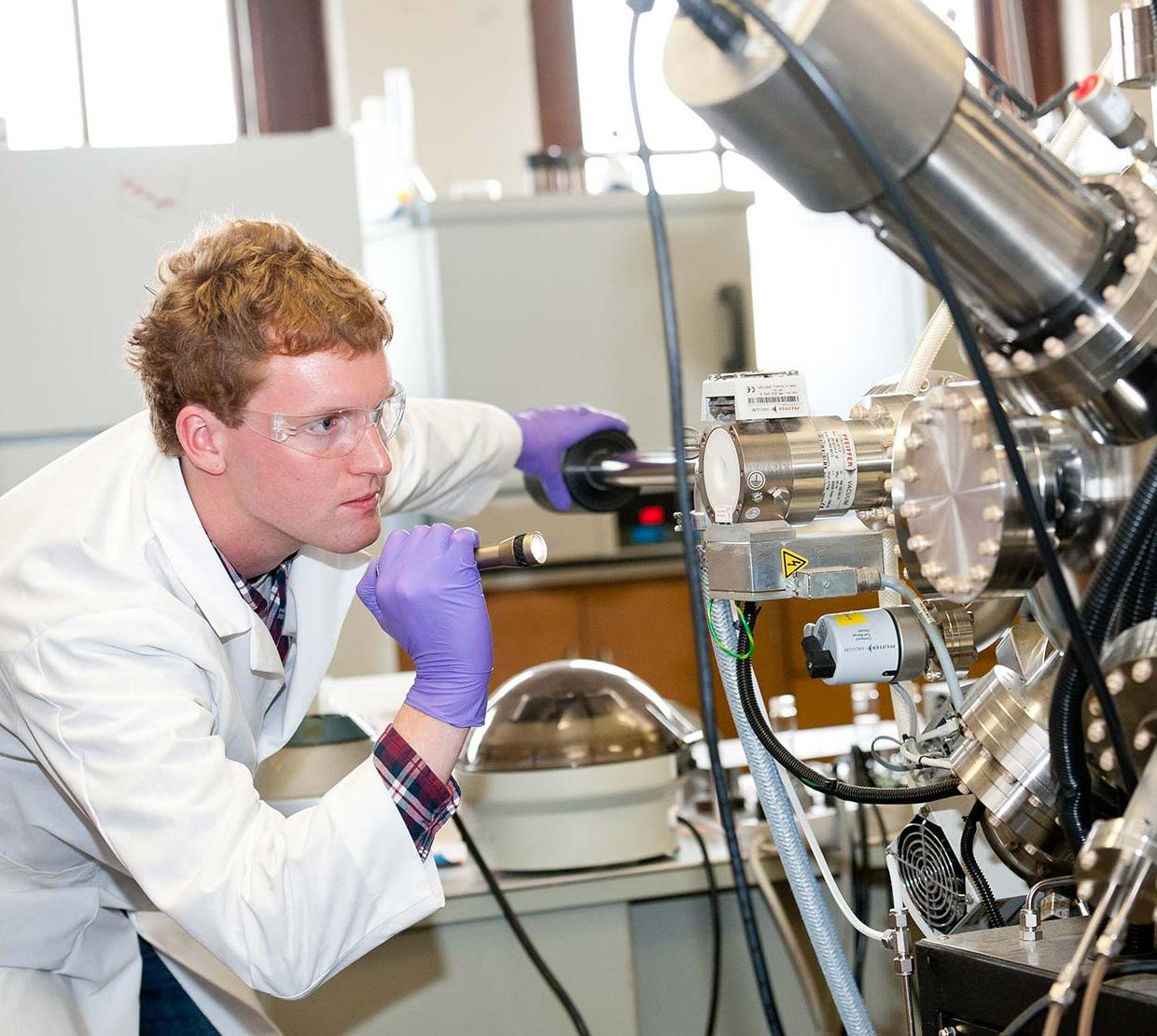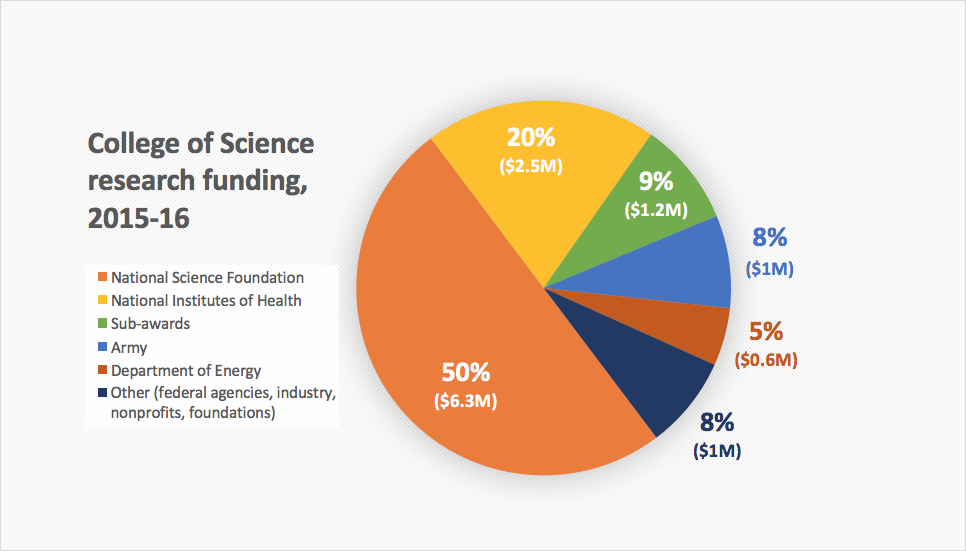Many of the College’s new grants fund projects in the life, biohealth and marine sciences, showing the broad impact Oregon State science faculty are having on human, environmental and marine health. In addition, mathematical sciences received a major award for research-based teacher preparation.
With government funding for science research limited and competition fierce, the College is making adjustments and investments in grant support for faculty and examining a model for supporting research funding through strategic relationships with foundations, donors, state agencies, and industry.
“Research is at the heart of the mission of our College and at OSU,“ said Sastry G. Pantula, dean of the College of Science.
“We are committed to our faculty and student success. We are increasing grant support for faculty and investing in a grant coordinator to offer stronger administrative support of large-scale research proposals. We will continue to provide training and mentoring support for our junior faculty and others in the development of research proposals.”
With this increased grant support, the goal is for more faculty to submit more high quality proposals and have more funding success.
Federal funding can have a domino effect across many types of organizations that fund science with many welcome side effects, according to a recent study published by PLOS One. The results suggest that federal research investment positively influences science funders, which are all part of a larger ecosystem.
They estimate that a 1% increase in federal research funding results in a 0.41% increase in nonprofit research funding, a 0.22% increase in state and local research funding, and a 0.47% increase in industry research funding, respectively. The researchers found that “federal funding plays a fundamental role in inducing complementary investments from other funding sources, with impacts varying across academic division, research capacity, and institutional control.”
Although federal funding rates saw historic lows, the Senate approved another $2 billion boost in 2017 for NIH, a 6.2% increase to $34.1 billion. This is the second year in a row that the Senate has slated the agency for a large increase after 12 years of flat budgets. The bill also includes $1.39 billion for Alzheimer’s disease research, a 40% increase. We are appreciative of our congressional staff for their support for federal funding for research and workforce development.
Congratulations to these faculty who received grant funding of $1 million and above, an impressive feat given the competitive climate for federal funding.
- Joe Beckman has been awarded a grant from the U.S. Army for his proposal exploring the “Development of Copper ATSM as a Therapeutic for SOD-Familial and Sporadic ALS” and a funding award from the Oregon Chapter of The ALS Association supporting his preclinical investigation of CuATSM in mice and dogs.
- Ryan Mehl has been awarded two grants for his work on nitrotyrosine (nitroTyr) proteins and genetic code expansion: a 4-year National Science Foundation award and a 5-year National Institutes of Health Award. His project will have a broad educational and scientific impact.
- Tom Dick has been awarded an NSF grant for his proposal, “Ambitious Math and Science Teaching Fellows,” to provide research-based teacher preparation courses and clinical experiences, professional development and support for teacher retention as part of the Noyce Teaching Fellows project.
- Juan Restrepo and Alix Gitelman are co-PIs on a grant to implement an NSF Research Traineeship at OSU. The project, “Risk and uncertainty quantification in marine science and policy,” encourages the development of bold and transformative models for graduate education in STEM fields.
The grant amount includes awards to faculty who are currently supported by the prestigious NSF CAREER Awards—the NSF’s top award given to junior faculty members for outstanding research and the effective application of that research in university teaching and education—as well as faculty who were awarded highly competitive funds for various research projects, ranging from support for undergraduate mathematics research to the impact of climate change.
While many faculty received grants in FY16, below are some of the top awards.
- Xiulei (David) Ji: CAREER Award from the National Science Foundation to design carbon anodes through a better understanding of structure-property relationships in potassium-ion batteries. He also received NSF funding to study Na-Ion storage in hard carbon.
- Adrian (Fritz) Gombart: an NIH grant to study Vitamin D, xanthohumol and nuclear receptors, targeting immunity, microbiota and the gut metabolome.
- Virginia Weis: an NSF grant to study glycan recognition and the role of innate immunity in cnidarian-dinoflagellate symbioses.
- Michael Blouin: an award from the U.S. Department of Energy/Bonneville Power Administration to evaluate the causes of hatchery and wild steelhead RRS.
- Colin Johnson: an NIH grant to support his in vivo and in vitro studies of the deafness associated protein otoferlin.
- Malgorzata Peszynska: two NSF grants for her project, “Phase transitions in porous media across multiple scales.”
Looking ahead Recently, the College has had some positive momentum with research awards totaling more than two million for FY2017.
- Rebecca Vega-Thurber received a three-year NSF grant for $746K for her collaborative research project, “Viral Reefscapes: The Role of Viruses in Coral Reef Health, Disease, and Biogeochemical Cycling.”
- Martin Schuster received a three-year NSF grant for $569K for his project, “Inter- and Intra-specific siderophore cheating in bacteria.
- Weihong Qiu received a three-year NSF grant for $520K for his collaborative research entitled “Dissecting the function, mechanism and regulation of OsKCH2: from single-molecule kinetics to cell division plane determination.”
- Thomas Sharpton received a three-year NSF award for $240K for his project, “Using the Phylogenetic Structure to Clarify the Evolutionary Ecological Distribution of Micro-organisms.”
- Heidi Schellman received a three-year NSF award of $160K to study simulation and design optimization for neutrino beamlines.





